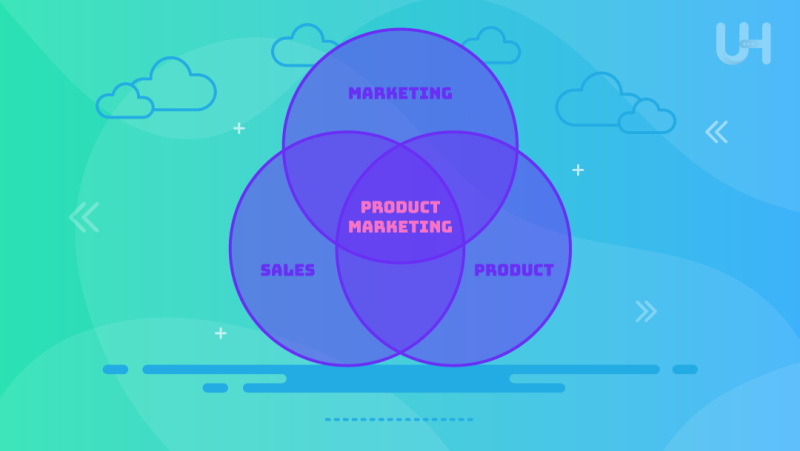Product marketing bridges the gap between a company’s product and its target audience. It means understanding the product, identifying the right audience, and creating strategies that ensure it resonates with that audience. Unlike general marketing, which takes on broader roles, product marketing focuses on positioning, messaging, and the overall go-to-market product marketing strategy.
It ensures that the product value is communicated effectively, and volumes of sales teams and prospective customers alike comprehend its benefits. In this blog, we cover everything from market research to the launch of a product: the key elements of product marketing and why it is so crucial for business success.
What is Product Marketing?
Product marketing is all about promoting and positioning the product in the market to reach the perfect audience, and the audience resonates with their needs. It covers understanding a product’s value, identifying target customers, and strategizing ways to communicate its benefits effectively. In contrast to more general marketing, product marketing narrowly focuses on driving product adoption, crafting tailored messaging, and developing go-to-market plans. This bridges the gap between product development and sales by ensuring both teams understand the product’s strengths and unique selling points.
Target Audience
Successful product marketing centers around understanding your target audience. The target audience is the select group of people who will benefit most from your product, usually having common demographic characteristics, interests, behaviors, and needs.
Once this audience is identified, it helps marketers create appropriate messaging that can pull on both pain points and motivations. Customer insights and effective research on market trends by product marketers will be necessary to identify the target audience effectively. A well-defined target audience provides information for subsequent marketing activities, including product positioning, tone, and focus of advertising to ensure effectiveness in terms of relevance and participation.
Market Research
- Customer Needs Understanding: Surveys, interviews, and focus groups should be conducted to gather information on expectations, pains, and what target customers are looking for in similar products.
- Market Trend Analysis: Stay abreast of the market’s state in terms of the latest technological advances and changes in consumer behavior. This will enable you to position your product to meet market demand both in the present and the future.
- Competitor Research: Analyze competitors’ products, pricing strategies, and marketing methodologies to identify gaps in the market and opportunities for differentiation. A robust VPS Hosting solution allows businesses to run simulations efficiently, analyze data, and scale based on competitor research insights, making it easier to stay ahead in the market.
- Identify opportunities: Use the information to find untapped markets or underserved customer segments and determine ways to provide unmatched value for those customers.
Positioning Strategy
A good positioning strategy is about how your product should be represented in the minds of the people of a targeted segment. It differentiates your product from all competitors with respect to its unique value and advantages. First, developing your positioning strategy requires you to clearly identify your product’s key strengths and their correspondence with your customers’ needs.
It involves clearly articulating how your product solves certain problems, why it is better than alternatives, and what makes it different. You have to create a catchy yet relatable positioning statement; this is crucial because it forms the basis for all marketing messages and guides how your product will be communicated across various channels and platforms.
Value Proposition
A value proposition is a short statement summarizing the unique benefits your product offers customers. It should describe why a customer should buy your product over others because it appeals to their needs and can demonstrate how the product will provide value.
A good value proposition should address either solving a particular problem or enhancing a private or business aspect in a customer’s life. It needs to point toward key advantages of the product, such as cost savings, efficiency, and convenience. In other words, the value proposition drives home the core message of interest, trust, and customer purchases to build brand awareness.
Product Messaging

Core Message
The core message of your product is the overriding statement summarizing the main value and benefit that it can provide. Transparent, clear-cut, and targeted to resonate with the target audience, it forms the basis of all marketing communications, ensuring a consistent message is projected across each platform. It outlines the key problems your product intends to solve and why that truly matters to customers.
Supporting Messages
Supporting messages describe features and benefits related to the core message in detail. They provide further context, emphasizing unique selling points, technical advantages, and, in general, the impact on the customer’s experience.
Powerful Hosting for Social Network Growth!
For businesses looking to launch and scale their products successfully, UltaHost’s Social Network Hosting provides the reliable infrastructure needed to support high-traffic platforms, ensuring smooth performance and scalability for your social media or networking product launch.
Go-to-Market Plan
A go-to-market plan articulates the strategy of how a product will be launched into the market and then become successful. Key components include identification of the target audience, value proposition, product positioning, pricing strategy, and distribution channels.
The GTM plan also lays out the marketing and sales tactics to drive awareness, demand, and adoption. Leveraging a solution like Cloudflare server helps ensure your product’s online presence optimizes for speed and security, which is critical for generating awareness and also customer engagement in highly competitive markets.
Customer Segmentation
Customer segmentation is the process by which a broad market is divided into distinct groups of people who share similar characteristics, needs, or behaviors. It helps businesses tailor their marketing efforts and product offerings to meet the unique demands of each segment.
Segments are normally based on demographics, gender, income, and location psychographics, including interests, values, and way of life. Behavioral and purchase history can also guide segmentation. Companies can draft more personalized messaging by understanding each specific group’s needs. This, in turn, would increase customer satisfaction and click-through rates, thus making for more effective marketing and, finally, better business performance.
Competitive Analysis
- Identify Key Competitors: Research and name your direct and indirect competitors to understand against whom you are competing in the market.
- Analyze Product Features: Compare your competitors’ products or service offerings to your own, defining strengths, weaknesses, and the most distinguishing features that make them different.
- Evaluate Marketing Strategies: Analyze each competitor’s method of bringing the product to market. Note price, messaging, advertising channels, and strategies for engaging customers.
- Assess Market Positioning: Recognize how the competitors position themselves in the marketplace if there is a gap or opportunity to position your product better to meet customer needs.
Sales Enablement
Sales enablement equips the sales teams with tools, resources, and information that may help them sell the product. Moreover, this could include know-your-product guides, sales scripts, training materials, or whatever else is necessary to ensure consistency in positioning and messaging across the board.
Empower sales personnel with the right messaging and communication strategies to effectively convey the product’s value proposition and counter customer objections. By incorrectly aligning marketing and sales, sales enablement smoothes buyers’ journeys, decreasing bounce rates while shrinking the time for selling. The result is that sales teams can become more efficient in engaging prospects and closing deals.
Product Launch
A product launch is the apex of any market-oriented, sales-focused initiative and product development effort that brings a new product into the marketplace. This requires an effective, well-coordinated strategy that encompasses pre-launch buzz, marketing campaigns, sales training, and also customer outreach.
It generally incorporates a mix of digital marketing, such as Facebook marketing, press releases, social media promotions, and events to build excitement and awareness. Successful launches also include strategy around performance tracking, listening for feedback, and making adjustments throughout. Lastly, a successful launch lays the groundwork for product adoption: driving sales early and effectively setting the product in the potential customers’ minds.
Conclusion
Product marketing is critical for a product’s success in the market. It involves aligning product features with customer needs and delivering a clear and compelling message. This plays a significant role in developing brand awareness, driving demand, and also supporting sales-skewed activities, from identifying the target audience to a go-to-market strategy.
In other words, efficient product marketing does not involve launching a product but continuous efforts to adapt to market changes, refine messaging, and meet customer expectations to outperform persistently.
For robust performance and reliable infrastructure to support high-demand products or social media platforms, UltaHost’s dedicated hosting server offers power, scalability, and security.
FAQ
What is product marketing?
Product marketing bridges the gap between a product and its audience by focusing on positioning, messaging, and go-to-market strategies.
Does product marketing differ from general marketing?
Product marketing differs from the general view of marketing in its approach to communicating a product’s unique value and ensuring that its benefits are crystal clear.
Why identify the target audience when marketing products?
Through personalized messaging, marketers can better grasp the target audience, which will help the product address their particular needs.
What is the significance of market research in product marketing?
Market research helps identify customers’ needs, market trends, and competitors, leading to the development of effective strategies.
What is a value proposition?
A value proposition is an articulated message describing what unique benefit a product or offering offers in delivering value by solving an issue.
What is a go-to-market in simple words?
The go-to-market plan encompasses how the launched product will realize a target audience, positioning, marketing tactics, and sales strategies.
How does sales enablement support product marketing?
Sales enablement arm sales teams with the best tools, facilities, and information to help them sell the product better.












